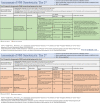The application of existing genotoxicity methodologies for grouping of nanomaterials: towards an integrated approach to testing and assessment
- PMID: 35525968
- PMCID: PMC9080165
- DOI: 10.1186/s12989-022-00476-9
The application of existing genotoxicity methodologies for grouping of nanomaterials: towards an integrated approach to testing and assessment
Abstract
The incorporation of nanomaterials (NMs) in consumer products has proven to be highly valuable in many sectors. Unfortunately, however, the same nano specific physicochemical properties, which make these material attractive, might also contribute to hazards for people exposed to these materials. The physicochemical properties of NMs will impact their interaction with biological surroundings and influence their fate and their potential adverse effects such as genotoxicity. Due to the large and expanding number of NMs produced, their availability in different nanoforms (NFs) and their utilization in various formats, it is impossible for risk assessment to be conducted on an individual NF basis. Alternative methods, such as grouping are needed for streamlining hazard assessment. The GRACIOUS Framework provides a logical and science evidenced approach to group similar NFs, allowing read-across of hazard information from source NFs (or non-NFs) with adequate hazard data to target NFs that lack such data. Here, we propose a simple three-tiered testing strategy to gather evidence to determine whether different NFs are sufficiently similar with respect to their potential to induce genotoxicity, in order to be grouped. The tiered testing strategy includes simple in vitro models as well as a number of alternative more complex multi-cellular in vitro models to allow for a better understanding of secondary NM-induced DNA damage, something that has been more appropriate in vivo until recently.
Keywords: Alternative physiological multi-cellular models; Genotoxicity; Grouping; Nanomaterials; Tiered testing strategy.
© 2022. The Author(s).
Conflict of interest statement
The authors declare no conflict of interest.
Figures




Similar articles
-
Grouping of orally ingested silica nanomaterials via use of an integrated approach to testing and assessment to streamline risk assessment.Part Fibre Toxicol. 2022 Dec 2;19(1):68. doi: 10.1186/s12989-022-00508-4. Part Fibre Toxicol. 2022. PMID: 36461106 Free PMC article.
-
Grouping of nanomaterials to read-across hazard endpoints: from data collection to assessment of the grouping hypothesis by application of chemoinformatic techniques.Part Fibre Toxicol. 2018 Sep 24;15(1):37. doi: 10.1186/s12989-018-0273-1. Part Fibre Toxicol. 2018. PMID: 30249272 Free PMC article.
-
Refinement of the selection of physicochemical properties for grouping and read-across of nanoforms.NanoImpact. 2022 Jan;25:100375. doi: 10.1016/j.impact.2021.100375. Epub 2021 Dec 14. NanoImpact. 2022. PMID: 35559881
-
Grouping of nanomaterials to read-across hazard endpoints: a review.Nanotoxicology. 2019 Feb;13(1):100-118. doi: 10.1080/17435390.2018.1506060. Epub 2018 Sep 5. Nanotoxicology. 2019. PMID: 30182776 Review.
-
New Approach Methods (NAMs) for genotoxicity assessment of nano- and advanced materials; Advantages and challenges.Mutat Res Genet Toxicol Environ Mutagen. 2025 May-Jun;904:503867. doi: 10.1016/j.mrgentox.2025.503867. Epub 2025 Mar 30. Mutat Res Genet Toxicol Environ Mutagen. 2025. PMID: 40382189 Review.
Cited by
-
DNA Oxidative Damage as a Sensitive Genetic Endpoint to Detect the Genotoxicity Induced by Titanium Dioxide Nanoparticles.Nanomaterials (Basel). 2022 Jul 29;12(15):2616. doi: 10.3390/nano12152616. Nanomaterials (Basel). 2022. PMID: 35957047 Free PMC article.
-
In chemico methodology for engineered nanomaterial categorization according to number, nature and oxidative potential of reactive surface sites.Environ Sci Nano. 2024 Jul 9;11(9):3744-3760. doi: 10.1039/d3en00810j. eCollection 2024 Sep 12. Environ Sci Nano. 2024. PMID: 39280766 Free PMC article.
-
Toxicity and Mechanisms of Engineered Nanoparticles in Animals with Established Allergic Asthma.Int J Nanomedicine. 2023 Jun 29;18:3489-3508. doi: 10.2147/IJN.S411804. eCollection 2023. Int J Nanomedicine. 2023. PMID: 37404851 Free PMC article. Review.
-
Understanding toxicity associated with boron nitride nanotubes: Review of toxicity studies, exposure assessment at manufacturing facilities, and read-across.J Mater Res. 2022 Oct 31;37(24):4620-4638. doi: 10.1557/s43578-022-00796-8. J Mater Res. 2022. PMID: 37193295 Free PMC article.
-
Dynamic QSAR modeling for predicting in vivo genotoxicity and inflammation induced by nanoparticles and advanced materials: a time-dose-property/response approach.J Nanobiotechnology. 2025 Jun 6;23(1):420. doi: 10.1186/s12951-025-03510-y. J Nanobiotechnology. 2025. PMID: 40481558 Free PMC article.
References
-
- Gkika DA, Vordos N, Magafas L, Mitropoulos AC, Kyzas GZ. Risk return profile of nanomaterials. J Mol Struct. 2021;1228:129740. doi: 10.1016/j.molstruc.2020.129740. - DOI
-
- Belade E, Chrusciel S, Armand L, Simon-Deckers A, Bussy C, Caramelle P, Gagliolo JM, Boyer L, Lanone S, Pairon JC, Kermanizadeh A, Boczkowski J. The role of p53 in lung macrophages following exposure to a panel of manufactured nanomaterials. Arch Toxicol. 2015;89:1543–1556. doi: 10.1007/s00204-014-1324-5. - DOI - PubMed
Publication types
MeSH terms
LinkOut - more resources
Full Text Sources

